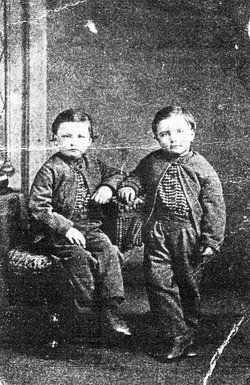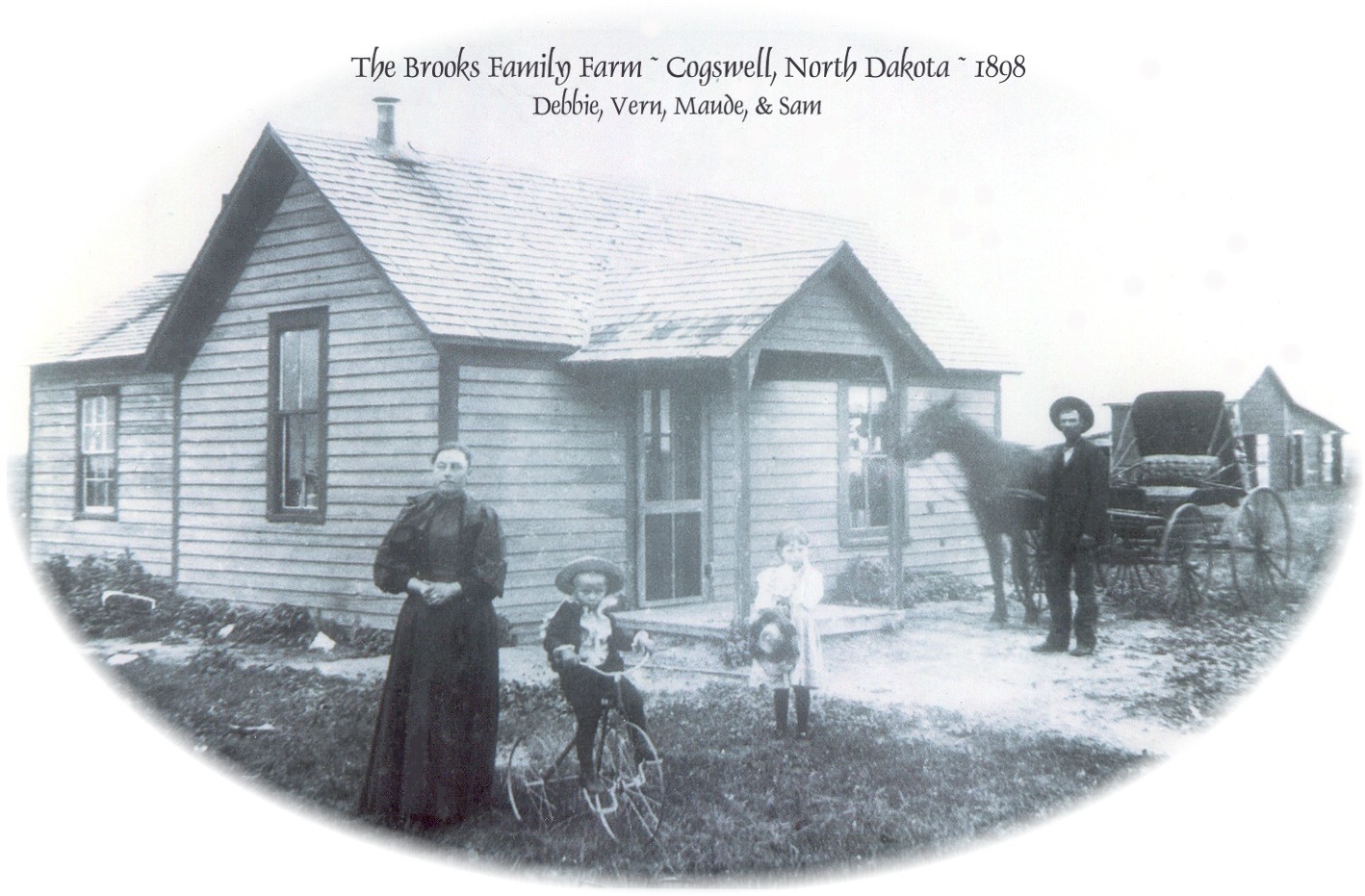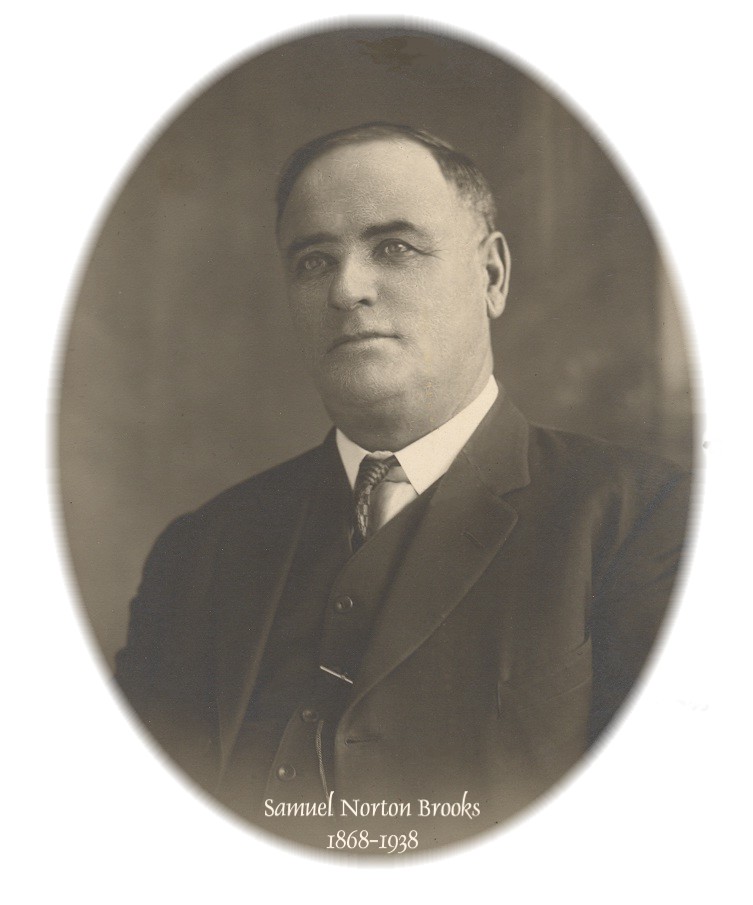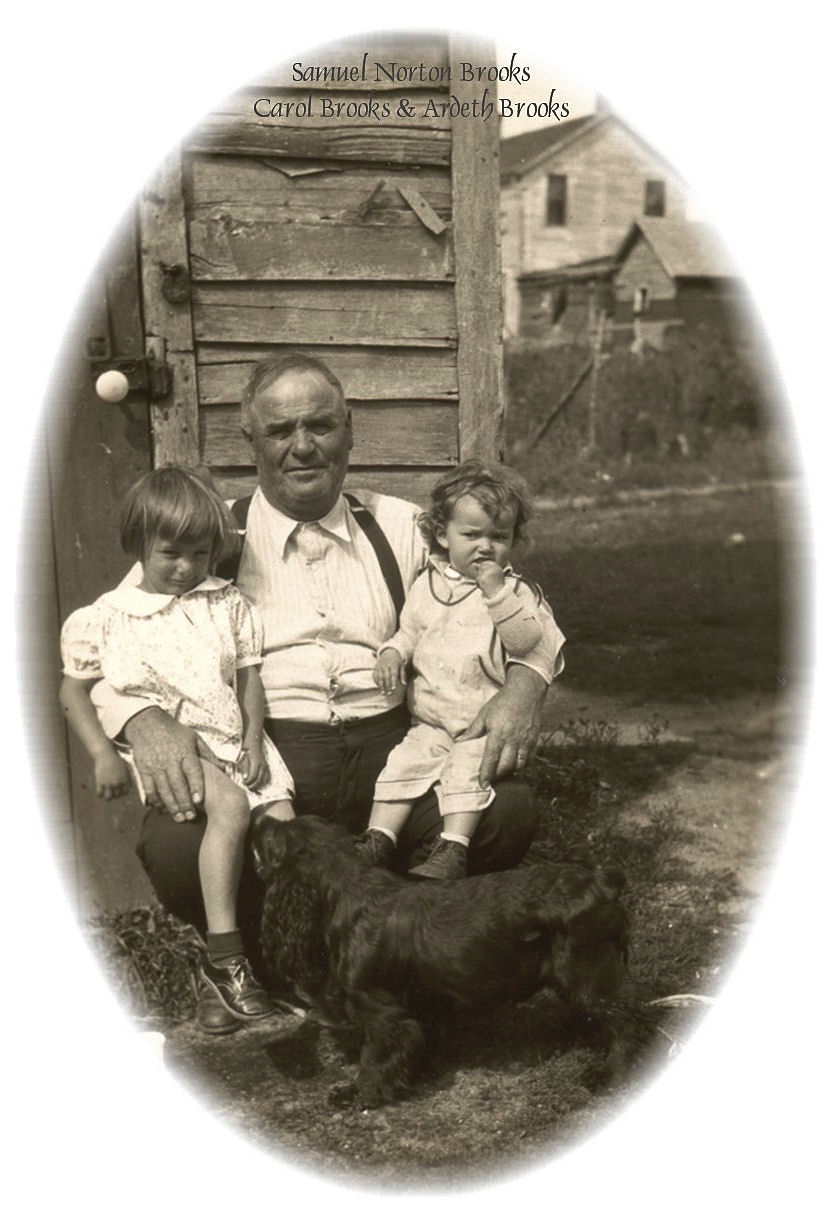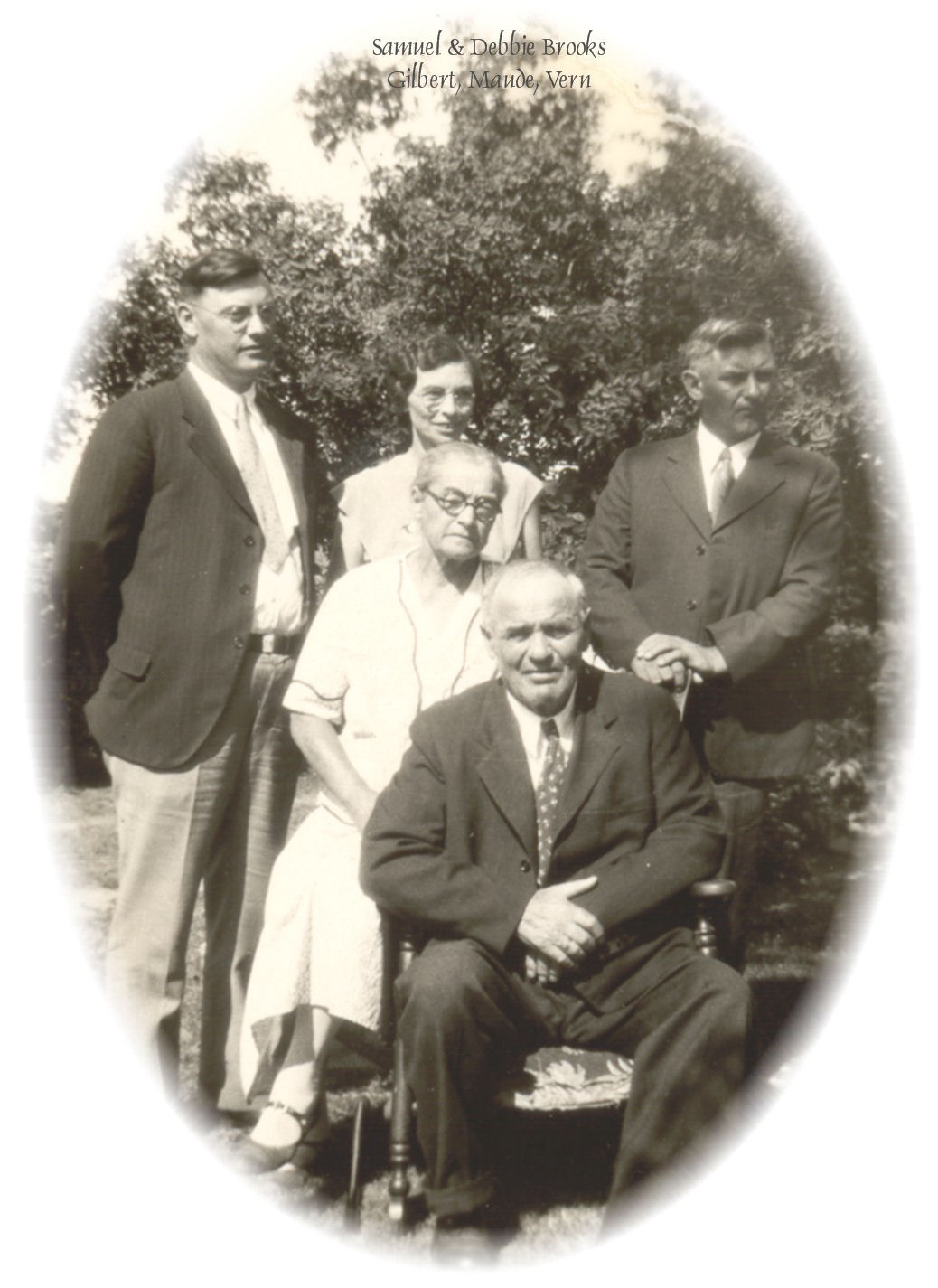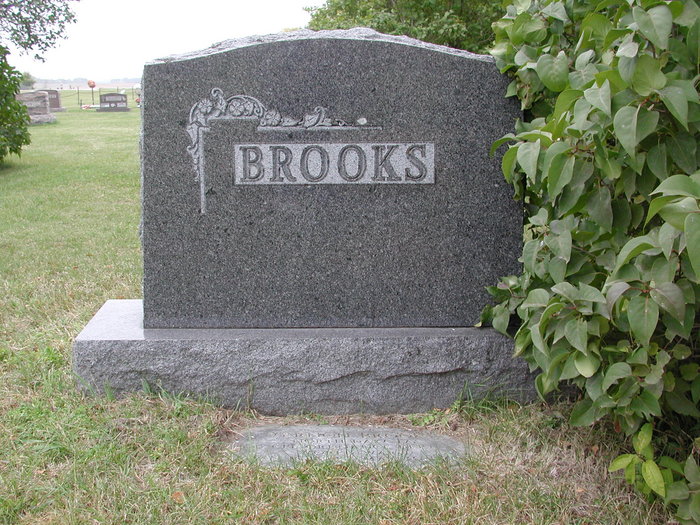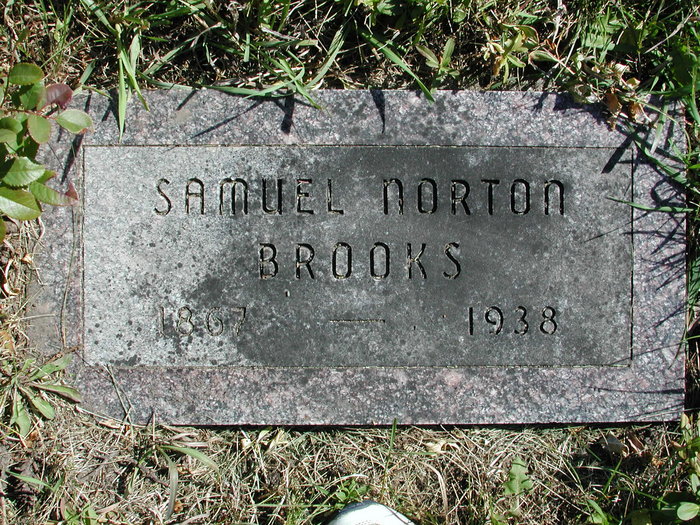Sam's father, Gilbert, and his older brother, Andy, operated a successful farm at Brookland. Sam staked out his own homestead claim directly west of his father's farm. By late June 1891, he had moved onto the 160-acre southeast quarter of section 25 in Sargent Township, four miles south of Cogswell. This made him his father's western neighbor. Of course, Sam had to go through the homestead application process in order to secure his property. He lacked the funds to travel to Fargo, so he entered his claim by affidavit at the courthouse in Forman. In that document, dated June 27, 1891, Sam stated, "I now reside on the land I desire to enter. Settlement commenced June 20th 1891. My improvements consist of a house 12 x 14 ft. and 150 acres broken, and that owing to the distance and expense of the trip, I am unable to appear at the district land office to make said entry." Sam's homestead application (no. 18918) was filed at the land office at Fargo on June 30, 1891. Six years later, on May 29, 1897, Sam arrived at the U.S. Circuit Court in Forman with two of his neighbors as witnesses. In making his homestead proof, Sam reported having established actual residence on his land "on or about Oct. 10th 1891…frame house, barn, granary, cow stable, hog pen, hen house…10 acres fenced, wire…150 acres under cultivation…value, $1200." He testified that he had a wife and two children and that he had not been absent from his property since settling upon it. He said he had cultivated 150 acres during each of seven seasons from 1891 to 1897. John A. Baird and Wallace W. Lamb, both residents of Brookland, provided written statements to verify Sam's testimony. At last, on October 22, 1897, the homestead patent (no. 8358) was granted and Sam Brooks owned his farm in Sargent Township.
Canadian-born Adam F. and Sarah (Birch) Prentice had a daughter named Susan Deborah. Called "Debbie" by friends, she met and fell in love with Sam Brooks. In late 1891, Sam (at Brookland but constructing a new home in Sargent Township) and Debbie (at Cogswell) took out a marriage license. Sam married Susan Deborah Prentice - see The History of Susan Deborah Prentice (Debbie Brooks) on December 16, 1891, in her father's home. Adam's name was misspelled "Andrew" on the marriage certificate. Later that day, Sam's sister, Nellie Brooks, married Elmer Soule in Gilbert Brooks' home at Brookland in Forman. The pastor of the Congregational Church, Rev. William Gillespie, was a very busy man on that wintry day, presiding at both weddings.
Sam and Debbie Brooks eventually had three children: Luella Maude, Vernon DeLysle Brooks (who married Mabel Peterson Gabrielson), and Gilbert. The photo shows Sam, Debbie, Maude and Vern Brooks on their homestead in Sargent Township circa 1898.
Sam, Debbie, and their three young children were at Sargent as of the 1900 U.S. Census. But farming didn't suit Sam, who possessed a more entrepreneurial nature. He moved his family to Cogswell in 1902. The Brookses and Prentices developed close ties, and Sam and his younger brother-in-law, Fred Prentice, jointly purchased a piece of property near Cogswell's western boundary on November 9, 1903, paying James Camp one hundred dollars (deed doc. no. 15622). Sam and Fred had a butcher shop, the City Meat Market, in Cogswell in 1903-1904. But both had their sights set elsewhere.
In his book, History of Otter Tail County, John Mason wrote that Sam left North Dakota in 1904. The 1905 Minnesota state census confirms this and indicates the Brooks family - and Prentices, too - had been in the state and village for a year and two months. Since the census was taken early in June 1905, it appears both families arrived around March 1904. Opportunities had beckoned among the gentle hills and clear lakes of Otter Tail County, Minnesota, and Sam and Fred soon built a general store in Richville - entering the mercantile business as Prentice & Brooks.
Sam and Fred were also fishing companions, and their names were included in the Twelfth Annual Report to the Board of Game and Fish Commissioners - 1905. Living in Richville, each paid $1.00 for ice fishing licenses for the 1905-06 season. The pristine lakes that dot this region - Marion, Rush, Otter Tail, Dead, and many others - were teaming with walleye, northern pike, and bass. Richville also lies in the center of a rich agricultural area. An interesting source of information on Brooks family life is The Bulletin - later called The Enterprise-Bulletin - a newspaper of nearby Perham, Minnesota. It reported: "August 3, 1905: Prentice & Brooks are building a large barn in the rear of their store. Also: "July 18, 1907: Mrs. A. F. Prentice of Cogswell, N.D. visits her son Fred and daughter Mrs. S. N. Brooks at this place. She returned with Mr. Brooks who was out to Cogswell looking after business." Mrs. A.F. Prentice was Sarah Prentice. Recall that the Prentice and Brooks farms were within a few miles of one another near Cogswell, North Dakota. The "business" mentioned here could have involved Sam's properties or the declining health of his mother, Frances. On "October 3, 1907: Mr. and Mrs. S. N. Brooks went to Cogswell, N.D. on account of the illness of Mr. Brooks' mother." It would be their last visit to see her - Frances Adsit Brooks died in Cogswell on September 30, 1907.
When the 1910 U.S. Census was taken, the Brooks family lived in Fergus Falls, 35 miles west of Richville. Why did they move there? Perhaps a lack of business in tiny Richville resulted in their moving to the larger town around 1909. In 1910, they rented a place at 608 E. Channing Street. Sam did "odd jobs," and the census indicates that he had not been out of work. A 1911 city business directory listed Sam, Debbie, and Maude at 532 E. Channing Street in Fergus Falls. Debbie's older sister, Jennie Prentice Bowman, owned a home a few doors down at 520 E. Channing Street - the two families were always very close. In 1911, Sam was a driver for J. C. Meyer Groceries. Soon afterward, he worked in the Glass Block Grocery in Fergus Falls, until his family's return to Richville around 1913.
The 1920 U.S. Census found Sam, Debbie, and 25-year-old Vern, in Richville. Vern was a butter maker at the local creamery. Sam, however, listed no occupation - although Fred Prentice and family lived next door, and Fred gave "commercial salesman, groceries" as his occupation. Maude had married Elmer Christensen, and the butter maker and his bride had moved south to Stewartville in Olmsted County. Sergeant Gilbert Brooks had joined the U.S. Army in April 1918 and served in a supply office at Fort Bliss, El Paso, Texas.
In 1930, Sam and Debbie were in Richville. Sam had "retired" from the general store business around 1923, yet spent some of his time representing the Rose Hill Nursery. The company was Minneapolis-based but had an office in Otter Tail County in nearby Battle Lake. The census informs us that the value of their Richville home - worth $6,000 near the onset of the Great Depression - was the highest in the village. Granddaughter Carol Mongoven explained that Sam had purchased the home of a doctor who once used the building as a "hospital." The doctor used various rooms of his home to house people whom he had treated. After Sam bought the place, it was perfect for visits from the kids and grandkids.
America was in the midst of the Great Depression when Sam and Debbie traveled from Richville to Kenyon, Minnesota, to be with Maude. Debbie was in very poor health. Suffering from cancer of the gall bladder, she had a bout of pneumonia in the autumn of 1934. She died in Kenyon when her heart failed at the age of 63 on December 4, 1934. Her remains were returned home to Richville, and her funeral was held at the M.E. Church on the 7th of December. Debbie Prentice Brooks was laid to rest in Richville Cemetery, a mile east of the village.
Sam's health, too, gradually declined, and by June 1937 he had entered the Vocational Hospital in Minneapolis. His visitors from time to time included his children and their families: Maude made the 60-mile trip north from Kenyon; Gilbert drove 100 miles north from Stewartville; and Vern traveled 200 miles south from Pelican Rapids. Sam had been a patient at the hospital for over six months when he took a turn for the worse. The children were summoned to his bedside. Vern motored to Minneapolis on Saturday and stayed until Monday morning, January 24, 1938. He left Minneapolis at 10 a.m., driving north through a terrible winter storm on the final 70-mile leg from Alexandria to Pelican Rapids. He arrived home exhausted at 5 p.m. and awoke the next morning to learn that his father had passed away at 7:30 the prior evening. Coronary thrombosis, the result of hypertension and arteriosclerosis, was listed as the cause of death. Samuel Norton Brooks was returned to Richville, and a funeral was held Friday from the Methodist Church with Reverend Gebhard officiating. He was buried next to Debbie in the Richville Cemetery outside of town along Highway 14. Their graves in the Brooks family plot are marked with simple marble stones.
Sam's father, Gilbert, and his older brother, Andy, operated a successful farm at Brookland. Sam staked out his own homestead claim directly west of his father's farm. By late June 1891, he had moved onto the 160-acre southeast quarter of section 25 in Sargent Township, four miles south of Cogswell. This made him his father's western neighbor. Of course, Sam had to go through the homestead application process in order to secure his property. He lacked the funds to travel to Fargo, so he entered his claim by affidavit at the courthouse in Forman. In that document, dated June 27, 1891, Sam stated, "I now reside on the land I desire to enter. Settlement commenced June 20th 1891. My improvements consist of a house 12 x 14 ft. and 150 acres broken, and that owing to the distance and expense of the trip, I am unable to appear at the district land office to make said entry." Sam's homestead application (no. 18918) was filed at the land office at Fargo on June 30, 1891. Six years later, on May 29, 1897, Sam arrived at the U.S. Circuit Court in Forman with two of his neighbors as witnesses. In making his homestead proof, Sam reported having established actual residence on his land "on or about Oct. 10th 1891…frame house, barn, granary, cow stable, hog pen, hen house…10 acres fenced, wire…150 acres under cultivation…value, $1200." He testified that he had a wife and two children and that he had not been absent from his property since settling upon it. He said he had cultivated 150 acres during each of seven seasons from 1891 to 1897. John A. Baird and Wallace W. Lamb, both residents of Brookland, provided written statements to verify Sam's testimony. At last, on October 22, 1897, the homestead patent (no. 8358) was granted and Sam Brooks owned his farm in Sargent Township.
Canadian-born Adam F. and Sarah (Birch) Prentice had a daughter named Susan Deborah. Called "Debbie" by friends, she met and fell in love with Sam Brooks. In late 1891, Sam (at Brookland but constructing a new home in Sargent Township) and Debbie (at Cogswell) took out a marriage license. Sam married Susan Deborah Prentice - see The History of Susan Deborah Prentice (Debbie Brooks) on December 16, 1891, in her father's home. Adam's name was misspelled "Andrew" on the marriage certificate. Later that day, Sam's sister, Nellie Brooks, married Elmer Soule in Gilbert Brooks' home at Brookland in Forman. The pastor of the Congregational Church, Rev. William Gillespie, was a very busy man on that wintry day, presiding at both weddings.
Sam and Debbie Brooks eventually had three children: Luella Maude, Vernon DeLysle Brooks (who married Mabel Peterson Gabrielson), and Gilbert. The photo shows Sam, Debbie, Maude and Vern Brooks on their homestead in Sargent Township circa 1898.
Sam, Debbie, and their three young children were at Sargent as of the 1900 U.S. Census. But farming didn't suit Sam, who possessed a more entrepreneurial nature. He moved his family to Cogswell in 1902. The Brookses and Prentices developed close ties, and Sam and his younger brother-in-law, Fred Prentice, jointly purchased a piece of property near Cogswell's western boundary on November 9, 1903, paying James Camp one hundred dollars (deed doc. no. 15622). Sam and Fred had a butcher shop, the City Meat Market, in Cogswell in 1903-1904. But both had their sights set elsewhere.
In his book, History of Otter Tail County, John Mason wrote that Sam left North Dakota in 1904. The 1905 Minnesota state census confirms this and indicates the Brooks family - and Prentices, too - had been in the state and village for a year and two months. Since the census was taken early in June 1905, it appears both families arrived around March 1904. Opportunities had beckoned among the gentle hills and clear lakes of Otter Tail County, Minnesota, and Sam and Fred soon built a general store in Richville - entering the mercantile business as Prentice & Brooks.
Sam and Fred were also fishing companions, and their names were included in the Twelfth Annual Report to the Board of Game and Fish Commissioners - 1905. Living in Richville, each paid $1.00 for ice fishing licenses for the 1905-06 season. The pristine lakes that dot this region - Marion, Rush, Otter Tail, Dead, and many others - were teaming with walleye, northern pike, and bass. Richville also lies in the center of a rich agricultural area. An interesting source of information on Brooks family life is The Bulletin - later called The Enterprise-Bulletin - a newspaper of nearby Perham, Minnesota. It reported: "August 3, 1905: Prentice & Brooks are building a large barn in the rear of their store. Also: "July 18, 1907: Mrs. A. F. Prentice of Cogswell, N.D. visits her son Fred and daughter Mrs. S. N. Brooks at this place. She returned with Mr. Brooks who was out to Cogswell looking after business." Mrs. A.F. Prentice was Sarah Prentice. Recall that the Prentice and Brooks farms were within a few miles of one another near Cogswell, North Dakota. The "business" mentioned here could have involved Sam's properties or the declining health of his mother, Frances. On "October 3, 1907: Mr. and Mrs. S. N. Brooks went to Cogswell, N.D. on account of the illness of Mr. Brooks' mother." It would be their last visit to see her - Frances Adsit Brooks died in Cogswell on September 30, 1907.
When the 1910 U.S. Census was taken, the Brooks family lived in Fergus Falls, 35 miles west of Richville. Why did they move there? Perhaps a lack of business in tiny Richville resulted in their moving to the larger town around 1909. In 1910, they rented a place at 608 E. Channing Street. Sam did "odd jobs," and the census indicates that he had not been out of work. A 1911 city business directory listed Sam, Debbie, and Maude at 532 E. Channing Street in Fergus Falls. Debbie's older sister, Jennie Prentice Bowman, owned a home a few doors down at 520 E. Channing Street - the two families were always very close. In 1911, Sam was a driver for J. C. Meyer Groceries. Soon afterward, he worked in the Glass Block Grocery in Fergus Falls, until his family's return to Richville around 1913.
The 1920 U.S. Census found Sam, Debbie, and 25-year-old Vern, in Richville. Vern was a butter maker at the local creamery. Sam, however, listed no occupation - although Fred Prentice and family lived next door, and Fred gave "commercial salesman, groceries" as his occupation. Maude had married Elmer Christensen, and the butter maker and his bride had moved south to Stewartville in Olmsted County. Sergeant Gilbert Brooks had joined the U.S. Army in April 1918 and served in a supply office at Fort Bliss, El Paso, Texas.
In 1930, Sam and Debbie were in Richville. Sam had "retired" from the general store business around 1923, yet spent some of his time representing the Rose Hill Nursery. The company was Minneapolis-based but had an office in Otter Tail County in nearby Battle Lake. The census informs us that the value of their Richville home - worth $6,000 near the onset of the Great Depression - was the highest in the village. Granddaughter Carol Mongoven explained that Sam had purchased the home of a doctor who once used the building as a "hospital." The doctor used various rooms of his home to house people whom he had treated. After Sam bought the place, it was perfect for visits from the kids and grandkids.
America was in the midst of the Great Depression when Sam and Debbie traveled from Richville to Kenyon, Minnesota, to be with Maude. Debbie was in very poor health. Suffering from cancer of the gall bladder, she had a bout of pneumonia in the autumn of 1934. She died in Kenyon when her heart failed at the age of 63 on December 4, 1934. Her remains were returned home to Richville, and her funeral was held at the M.E. Church on the 7th of December. Debbie Prentice Brooks was laid to rest in Richville Cemetery, a mile east of the village.
Sam's health, too, gradually declined, and by June 1937 he had entered the Vocational Hospital in Minneapolis. His visitors from time to time included his children and their families: Maude made the 60-mile trip north from Kenyon; Gilbert drove 100 miles north from Stewartville; and Vern traveled 200 miles south from Pelican Rapids. Sam had been a patient at the hospital for over six months when he took a turn for the worse. The children were summoned to his bedside. Vern motored to Minneapolis on Saturday and stayed until Monday morning, January 24, 1938. He left Minneapolis at 10 a.m., driving north through a terrible winter storm on the final 70-mile leg from Alexandria to Pelican Rapids. He arrived home exhausted at 5 p.m. and awoke the next morning to learn that his father had passed away at 7:30 the prior evening. Coronary thrombosis, the result of hypertension and arteriosclerosis, was listed as the cause of death. Samuel Norton Brooks was returned to Richville, and a funeral was held Friday from the Methodist Church with Reverend Gebhard officiating. He was buried next to Debbie in the Richville Cemetery outside of town along Highway 14. Their graves in the Brooks family plot are marked with simple marble stones.
Bio by: janealogy50
